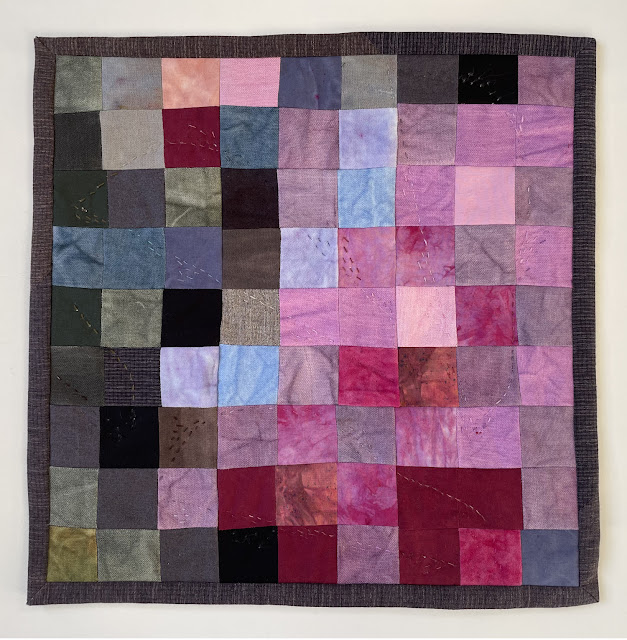We played various music games growing up. One involved clapping out a rhythm and the other person would have to guess the song. Another, perhaps like "Name That Tune," rolled out a song one note at a time and you would try to guess the song in as few notes as possible. Beethoven's Fifth Symphony, for example, could probably be identified by anyone after hearing the first four notes. Which brings me to the visual concept and questions behind some small quilts I have been working on. How much of a picture do you need to see to be able to get a feeling for the object presented within it? Can an object be represented by its parts and still be recognizable? What does it take to find a pleasing composition that is ultimately strong enough on its own even without being recognizable at all?
I also looked more at Dorothy Caldwell's work and the work of Claire Benn. There is a (long) discussion/interview with them on YouTube that gave me more inspiration, particularly in thinking about pigments again. I haven't been painting with acrylic inks on paper for a couple of years, and I wanted to use up the inks before they used themselves up.
I began with photos I had taken that have some kind of emotional pull for me. In my photo program (I use Affinity Photo), I used the crop tool as a viewfinder and took a variety of tiny pieces (9x9 pixels) from each picture until I found the composition that grabbed me (this took a while, and I often took ten samples from which to choose), then printed out the chosen one and interpreted the colors with squares of cloth. The squares were originally 2.25 inches, the finished quilts measure approximately 16 inches square (40.5 cm).
Pond/No Collecting. A friend and I took a walk at Point Pinole Regional Shoreline and came across an unnamed pond, the water rippling slightly like an Impressionist painting, the only signage warned visitors to leave everything in place. My friend said sometimes there were frogs in the pond. That day we saw water weeds and some pairs of very shy Northern Shovelers. We took the "Owl Alley Trail" on the way back.
Gift from a Gull, a Shell. This quilt is based on the same shell that inspired my larger quilt, Study for a Finding (blog post here). I had also just finished the book, The Sound of the Sea: Seashells and the Fate of the Oceans by Cynthia Barnett. A lovely, informative, and thoughtful book about the cultural, natural, and scientific history of shells and the creatures that live within them. Barnett vividly brings the subject to life. I have never been a big shell collector, but the book made me go back to look at my mussel shell and want to go to the ocean, or at least to the Richmond Marina, dining room of the gulls.
Blooms Before Leaves, Magnolia. I love especially how the magnolia blooms in winter, the blossoms arriving before the leaves. I often take photographs of them, and if you search this blog for "tree" or "magnolia," you'll find some. Magnolia has come up in my art before in my artist book, Tree (posted here) and my appliqué quilt, Magnolia (here), and a needlepoint box (here).
For many of the squares in these quilts, I applied watered down acrylic inks to a larger piece of dampened linen, scrunched it, let it dry, dampened it, ironed it, and cut it up. I unraveled some of the loose threads at the edges to use for hand quilting.
First impressions. Flash understanding. How many notes? Minimalism? Abstraction? How much and what kind of information do you need to see, feel, understand? I like these questions, how they can lead to new paths, winding back and out into territory both familiar and strange.





Comments